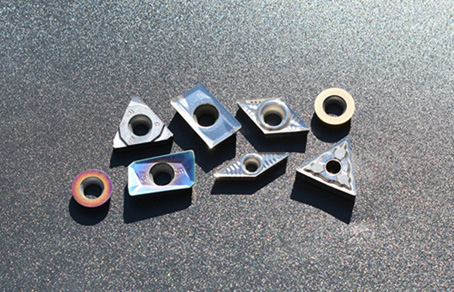
How to select cemented carbide blade?
Carbide insert is a widely used tool material for high-speed machining. This type of material is produced by powder metallurgy and consists of hard carbide particles and soft metal adhesives. At present, there are hundreds of different compositions of WC-based cemented carbide, most of which use cobalt as the binder, nickel and chromium are also common binder elements, and other alloy elements can also be added.
Selection of cemented carbide blade: Turning of cemented carbide blade is the main process of cemented carbide processing technology, especially in the heavy machinery manufacturing industry, the selection of tool is particularly important. According to the different processing equipment, compared with ordinary machining, heavy turning has the characteristics of large cutting depth, low cutting speed and slow feed speed. The machining allowance on one side can reach 35-50 mm. In addition, due to the poor balance of the workpiece, the uneven distribution of the number of machine tools and the unbalance of the parts and other factors, the vibration of the machining allowance causes the dynamic balancing process to consume a large amount of mobile time and auxiliary time. Therefore, in order to process heavy parts and improve the productivity or utilization rate of mechanical equipment, we must start with increasing the thickness and feed rate of the cutting layer. We should pay attention to the selection of cutting parameters and blades, improve the structure and geometry of blades, and consider the material of blades. Strength characteristics, thus increasing cutting parameters and significantly reducing operating time.
The commonly used blade materials include high-speed steel, cemented carbide, ceramics, etc. The large cutting depth can generally reach 30-50mm, and the allowance is uneven. There is a hardened layer on the surface of the workpiece. In the rough machining stage, blade wear mainly occurs in the form of abrasive wear The cutting speed is generally 15-20 m/min. Although the speed value is the agglomeration on the chip, the high temperature of cutting makes the contact point between the chip and the front tool surface in liquid state, thus reducing friction and inhibiting the agglomeration of the first generation of chips. The blade material shall be wear-resistant and impact resistant. The ceramic blade has high hardness, but low bending strength and low impact toughness. It is not suitable for large turning and has uneven edges. Cemented carbide has a series of advantages such as "high wear resistance, high bending strength, good impact toughness and high hardness", while the friction coefficient of cemented carbide is low, which can reduce cutting force and cutting temperature, and greatly improve the durability of the blade. Suitable for rough machining of high hardness materials and heavy turning. It is an ideal choice for turning blade materials.
Improving the turning speed of cemented carbide inserts in heavy machinery is one of the key factors to improve production efficiency and shorten production cycle. In this process, a large amount of surplus is cut into several strokes, and the depth of each stroke is very small. The cutting performance of the blade can greatly improve the cutting speed, thus improving the production efficiency, extending the service life, and reducing costs and profits.
ČAS PŘÍSPĚVKU: 2023-01-15













